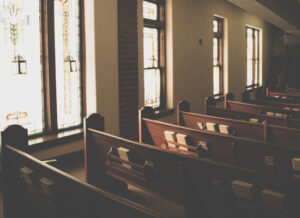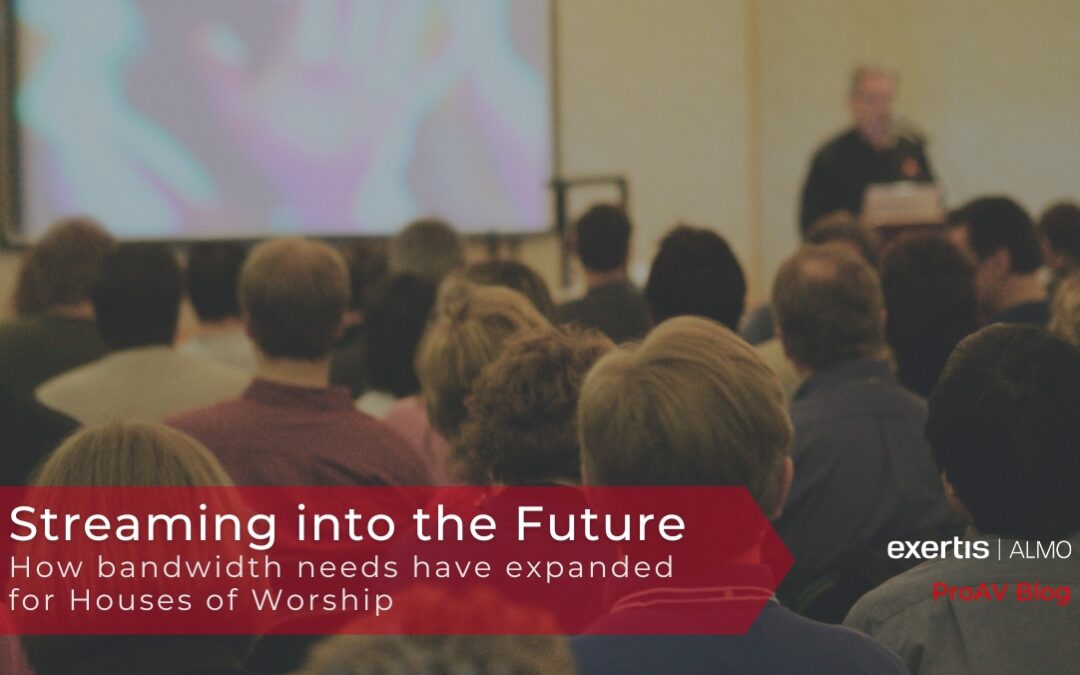 As we happily fast-forward through 2020 and 2021, I would now place House of Worship amongst the top 3. The reason is quite simple — as the Hospitality and Bar/Restaurant markets clearly battled the ripple effects from the pandemic, it was Houses of Worship who I believe felt a similar impact that few were prepared for. Houses of Worship rely on the some of the same factors as those other verticals do, but the impact can be overlooked if you are not able to predict the future. To survive, these places of worship must keep their doors open for the community and be able to spread their message to the congregation. Shutter those doors due to a global pandemic, and the message risks getting lost.
As we happily fast-forward through 2020 and 2021, I would now place House of Worship amongst the top 3. The reason is quite simple — as the Hospitality and Bar/Restaurant markets clearly battled the ripple effects from the pandemic, it was Houses of Worship who I believe felt a similar impact that few were prepared for. Houses of Worship rely on the some of the same factors as those other verticals do, but the impact can be overlooked if you are not able to predict the future. To survive, these places of worship must keep their doors open for the community and be able to spread their message to the congregation. Shutter those doors due to a global pandemic, and the message risks getting lost.
It was quite fitting that in February 2020, less than 30 days from the time that the state of NJ shut down, I found myself attending a project walk-through at Groveville United Methodist Church in Groveville, NJ. The purpose of this visit was to update the audio/visual and to use this new technology to attract new members in the future. One by one, the integrator and I ran through qualifying questions to better identify the needs they had as we assembled the perfect bill of materials. I asked the church’s technical director if he planned on streaming services or events, to which he immediately said, “We prefer to have folks here in person.” Having understandably not been able to predict what the future held, I certainly do not blame him or others for replying in that manner. As we fast-forwarded to April 2020, I remember a phone call with another integrator who seemed exasperated on the call as he explained, “I have this very small, rural church in Illinois, and they desperately need to be able to stream their services to reach their members at home.” This was the moment it became the clearest – Houses of Worship had a dire need to reach members near and far and to achieve that, Bandwidth was the top requirement.
 Streaming used to be a “cool to have” rather than a “have to have” need in this space. Most would probably associate streaming to the Mega Churches that we see on TV or in major cities. However, much like how the Pro AV industry and the push to use AVoIP, HoW have grown to accept that streaming simply cannot be overlooked. The question becomes, “Where do we even begin?” I say, start at bandwidth! There are two types of bandwidth in play here: the bandwidth that you are streaming at and the bandwidth that the stream is being watched at. Let us address these in two separate ways. Bandwidth is provided with two numbers – a download speed and an upload speed. When I refer to something as a 100×10 that means 100mb download and 10mb upload. When we are discussing streaming needs, we pay closer attention to the “UP” number specifically, because you are uploading the stream of the video and sharing this content to a larger audience. A general rule of thumb is that you have no less than a stable 5mb (megabits) upload speed to successfully stream. Given how most high speed cable internet providers start at 10mb upload speeds nowadays, this should not be too difficult to achieve. With that being said, any internet customer needs to understand that just because you are paying for a 100×10 cable package, does not mean you are receiving consistent 100×10 speeds. Those numbers are simply the “maximum advertised speeds” that the provider promotes, but when you factor in things like network traffic, time of day, and other extenuating circumstances (think about the number of people working from home and homeschooling in 2020 as an example), the speeds you receive in real time will almost normally be less. It is because of this that I never would recommend the bare minimum. For typical streaming needs, I would be comfortable recommending a 300×20 package or higher. This should ensure that you never run into issues when you can least afford to! Thinking back to the small, rural church I mentioned earlier, they were relying on a local DSL connection, which only had upload speeds of 1.5mb, hence their dire need to improve.
Streaming used to be a “cool to have” rather than a “have to have” need in this space. Most would probably associate streaming to the Mega Churches that we see on TV or in major cities. However, much like how the Pro AV industry and the push to use AVoIP, HoW have grown to accept that streaming simply cannot be overlooked. The question becomes, “Where do we even begin?” I say, start at bandwidth! There are two types of bandwidth in play here: the bandwidth that you are streaming at and the bandwidth that the stream is being watched at. Let us address these in two separate ways. Bandwidth is provided with two numbers – a download speed and an upload speed. When I refer to something as a 100×10 that means 100mb download and 10mb upload. When we are discussing streaming needs, we pay closer attention to the “UP” number specifically, because you are uploading the stream of the video and sharing this content to a larger audience. A general rule of thumb is that you have no less than a stable 5mb (megabits) upload speed to successfully stream. Given how most high speed cable internet providers start at 10mb upload speeds nowadays, this should not be too difficult to achieve. With that being said, any internet customer needs to understand that just because you are paying for a 100×10 cable package, does not mean you are receiving consistent 100×10 speeds. Those numbers are simply the “maximum advertised speeds” that the provider promotes, but when you factor in things like network traffic, time of day, and other extenuating circumstances (think about the number of people working from home and homeschooling in 2020 as an example), the speeds you receive in real time will almost normally be less. It is because of this that I never would recommend the bare minimum. For typical streaming needs, I would be comfortable recommending a 300×20 package or higher. This should ensure that you never run into issues when you can least afford to! Thinking back to the small, rural church I mentioned earlier, they were relying on a local DSL connection, which only had upload speeds of 1.5mb, hence their dire need to improve.
 The second type of bandwidth we need to be cognizant of is the bandwidth at which the video is being watched. Obviously, it is an impossible task to attempt to determine the bandwidths of everyone who is watching, so you might want to offer the stream in different forms: HD, 4K, etc. A good HD stream would fall under the 5mb recommendation I just made, whereas 4k would cause that to rise, but again, say 10-15mb most high speed cable options will suffice nowadays in regard to the content streaming. While talking about the content streaming, we cannot overlook other factors such as the overall number of devices on the customer’s network. Thinking about your own home as an easy example. You probably have cell phones, smart TVs, thermostats, alarm systems, tablets, PC’s and more all tied to your home network. If you now apply that same thought to HOW you may have some similarities such as cell phones, PC’s etc. but now you might also have streaming cameras, audio components, assistive listening devices and more to consider. It is because of this that many HOW will look to a Dedicated Internet Access (aka Fiber) because it is as the name implies. You are receiving a dedicated service for your building that is backed by an SLA (service level agreement) therefore; you are receiving the speeds you are paying for. It might be wiser to look at a 50×50 DIA service instead of that 300×20-cable service, based on what your needs are and what your network looks like. Sure there is an increase in cost with DIA, but the peace of mind you will receive each time you attempt to stream a service is worth it in most cases. Wouldn’t you agree?
The second type of bandwidth we need to be cognizant of is the bandwidth at which the video is being watched. Obviously, it is an impossible task to attempt to determine the bandwidths of everyone who is watching, so you might want to offer the stream in different forms: HD, 4K, etc. A good HD stream would fall under the 5mb recommendation I just made, whereas 4k would cause that to rise, but again, say 10-15mb most high speed cable options will suffice nowadays in regard to the content streaming. While talking about the content streaming, we cannot overlook other factors such as the overall number of devices on the customer’s network. Thinking about your own home as an easy example. You probably have cell phones, smart TVs, thermostats, alarm systems, tablets, PC’s and more all tied to your home network. If you now apply that same thought to HOW you may have some similarities such as cell phones, PC’s etc. but now you might also have streaming cameras, audio components, assistive listening devices and more to consider. It is because of this that many HOW will look to a Dedicated Internet Access (aka Fiber) because it is as the name implies. You are receiving a dedicated service for your building that is backed by an SLA (service level agreement) therefore; you are receiving the speeds you are paying for. It might be wiser to look at a 50×50 DIA service instead of that 300×20-cable service, based on what your needs are and what your network looks like. Sure there is an increase in cost with DIA, but the peace of mind you will receive each time you attempt to stream a service is worth it in most cases. Wouldn’t you agree?
Bandwidth within HOW is not a “one size fits all” model. I have already mentioned high-speed cable, DIA, and DSL as examples of what is out there. You also have wireless and satellite services, which in the right situation, could still be viable sources. What do you do when you are a small/rural church with no cable or fiber internet available within 100 miles? You possibly turn to a satellite internet service, which is available, nationwide and while not as adequate as a 10mb upload speed, can still offer 4mb, which for a small church should do the trick. The key is- options are available to nearly everyone! For houses of worship and integrators alike, there are more bandwidth options than ever before to help make streaming into the future a PRESENT reality.
Want to know more about streaming for Houses of Worship?
Check out Patrick Booth’s “Behind the Panel” blog on Cameras for the HOW market: HERE
Enjoy this blog?
Let Rob know over on LinkedIn …and/or connect with #TeamExertisAlmo on our LinkedIn company page.

Rob Voorhees | CTS, CTP, DSCE, CTNS, Dante
Business Development Manager
Supported Manufacturers: Business Communications Services, and Harman: AKG, AMX, BSS, Crown, DBX, JBL, Soundcraft, Martin Lighting








